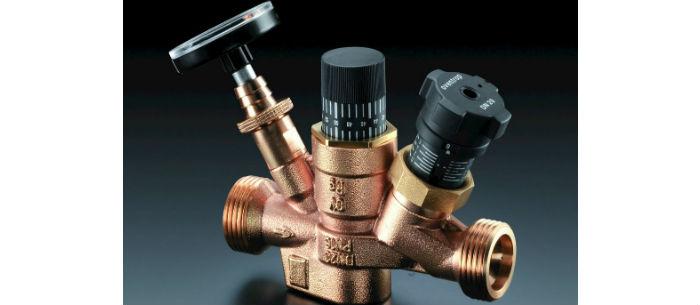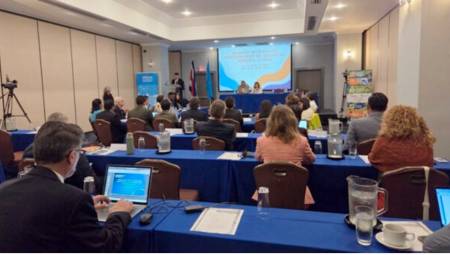 The use of thermal balancing valves allows a hot water system to operate efficiently and at low cost.
The use of thermal balancing valves allows a hot water system to operate efficiently and at low cost.
by David Corner*
To ensure that the hot water recirculation system works efficiently and economically, it is essential to balance the circuit so that all points along the system reach the flow required to maintain the ideal temperature.
If proper balance is not reached, the most remote areas will take longer to reach the desired outlet temperature. Additionally, areas that do not reach appropriate circulation temperatures will have a higher risk of growing bacteria such as Legionella.
Traditionally, hot water balancing has been done with static balancing valves. Due to the low flow rates required to meet the demand for hot water in the recirculation circuit, the process has depended on the return temperature, measured with a contact thermometer and almost closed balancing valves. One way to overcome this scenario has been to increase the flow to levels that can be measurable in a conventional low-flow measuring station. This forces the designer and the installer to work with appreciable flows, which results in an increase in the volume of water circulation. This increase results in an increase in the sizing of the pump, as well as in loss of energy and heat required to raise the temperature of the additional water.
If a hot water supply point is opened, the dynamics of water circulation change when the fluid takes the path of least resistance to the open outlet. At this point, the static balance achieved with the use of traditional valves has very little effect and will not return to be effective while a drain occurs somewhere in the system.
Adjusting the circulation of the hot water system is very difficult, even in ideal situations, due to the low flow rates and the use of contact thermometers. However, the exercise becomes even more difficult for commissioning engineers, when it is expected to carry out the process, while the building is filled with a number of shops trying to finish their renovations before the inauguration of the commercial space. It is inevitable that the water drains at different points, while the commissioning is intended. These dynamic changes in the availability of water at return trigger a poorly balanced system.
Essentially, the goal is to balance the water in the circuit to reach the right temperature along the entire recirculation line. The best way to do this is to monitor the temperature in each branch of the pipe and continuously increase or decrease the flow rate to reach the desired temperature in reaction to the opening of the different supply points. This is not possible with traditional valves.
Thermal balancing valves are designed to offer this level of control. These valves measure the temperature of the water when it passes through the sensor and the flow rate is adjusted according to this measurement. The valves come preset by default or can be adjustable on site, to a desired temperature. If the measured water temperature is very low with respect to the adjusted temperature, the valve will open, allowing the passage of more hot water that will increase the return temperature. If the measured water temperature is equal to or higher than the adjusted temperature, the valve will quickly reduce the passage of hot water, allowing heat to be lost on return.
It is important that when the valve closes, it always allows the circulation of a minimum flow or residual flow. It is necessary that the valve always allows the passage of water through the sensor to control the temperature. More importantly, the complete closure of the valve could cause an undesirable stagnation of water.
Using these valves, circulation is constantly monitored mechanically and return water will come from all parts of the system depending on demand. The system is dynamically controlled and any measuring station on the branches will not have the frequency of measurements offered by the thermal balancing valve with the consequent flow variations necessary to maintain the desired temperature. Having the recirculation line in this way balanced, it is not necessary to place other static balancing valves or measuring elements on the branches.
When we use thermal balancing valves, a balancing or commissioning process is not required. It is only necessary to adjust the desired temperature in each valve, as long as it is different from the one that comes factory adjusted by default. It is recommended to energize the hot water system and let the water circulate for 48 hours to allow the system and valves to reach their optimal fit.
After this period, the temperatures in the sausage thermometers should be checked. The BMS monitoring system may require the installation of sensors in certain reference positions to electronically display the temperature of the line.
When designing systems to prevent Legionella outbreaks, a method of disinfection of the hot water recirculation line should be taken into account. The risk assessment determines the frequency and execution time of the disinfection process. It is essential that all parts of the hot water system are periodically disinfected by raising the temperature of storage and distribution of water, above 70ºC to exterminate the Spores of Legonella.
To minimize the period of high temperature required for disinfection, it is advisable to increase the flow through the pipe. Thermal balancing valves are able to recognize the high temperature by passing through the sensor, completely opening the valve in "disinfection" mode.
To prevent the hot water from reaching only the hydraulically favored circuits, the thermal balancing valves are closed until the residual flow, once they have reached 70ºC. In order to optimize the process, the BMS must monitor the temperature at the extremities of the system, so that it can be reduced to the moment when the disinfection temperature is reached at the last point.
The use of thermal balancing valves for temperature control during regular operation and disinfection periods ensure the most economical and efficient operation from the point of view of energy, hygiene and comfort.
* David Corner, Technical Manager Oventrop GmbH & Co. KG. For information in Latin America you can write to Thais Vega at the email [email protected]














